Organizational Behaviour at GSK: Leadership and Motivational Theories
VerifiedAdded on 2020/07/22
|14
|4230
|73
Report
AI Summary
This report examines the organizational behaviour of GlaxoSmithKline (GSK), a leading healthcare company. It delves into the company's structure, culture, and how these elements influence employee performance. The report explores various leadership styles, with a focus on democratic and laissez-faire approaches, and contrasts them with the autocratic style used by LEO Pharma. It analyzes organizational theories such as scientific management, decision theory, and systems approaches, highlighting their application within GSK. The impact of personal, psychological, demographic, and environmental factors on employee behaviour is also assessed. Furthermore, the report discusses the importance of motivation, various motivational theories, and the role of leadership in fostering employee efficiency and achieving organizational goals. The report emphasizes the significance of understanding individual behaviours and creating a comfortable workplace environment to enhance overall performance.
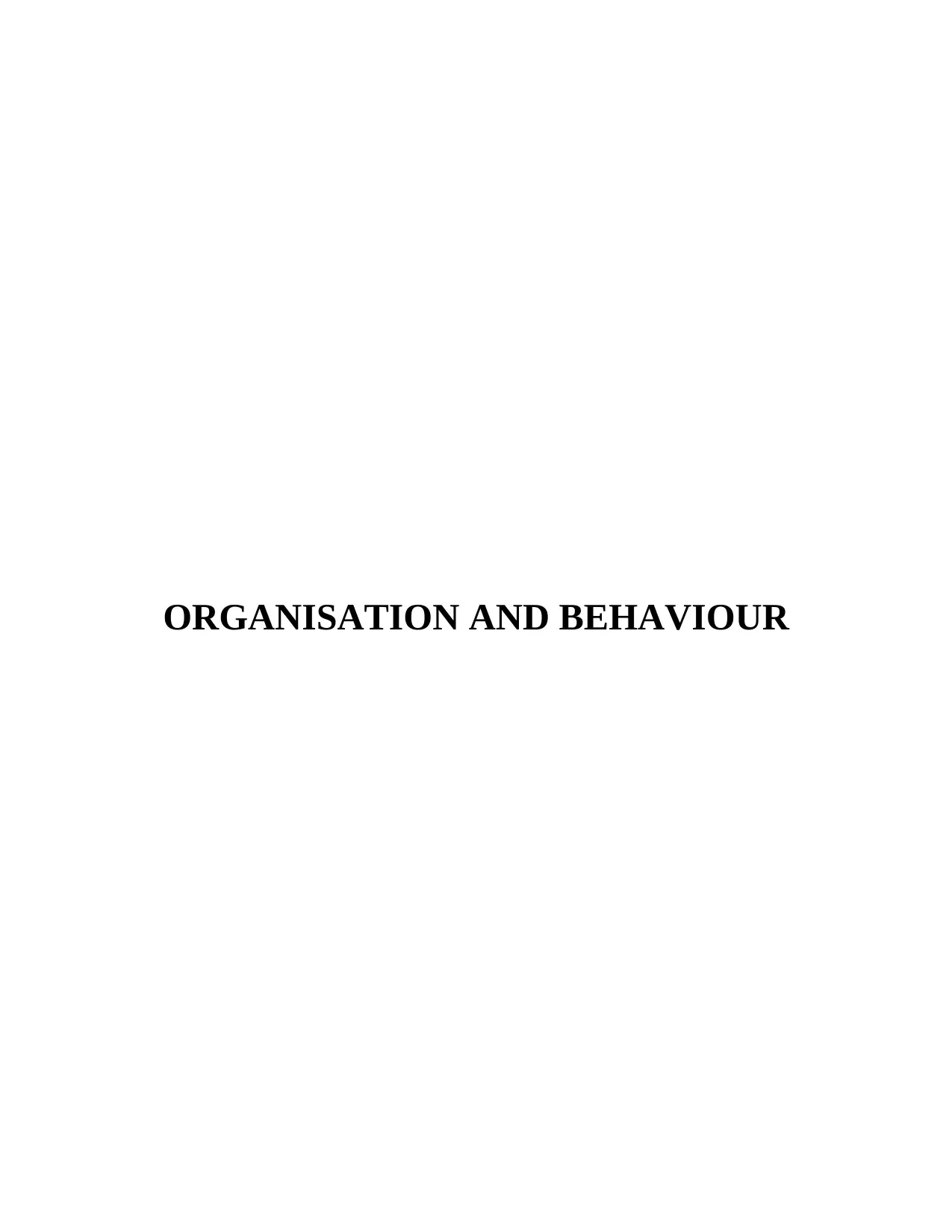
ORGANISATION AND BEHAVIOUR
Paraphrase This Document
Need a fresh take? Get an instant paraphrase of this document with our AI Paraphraser
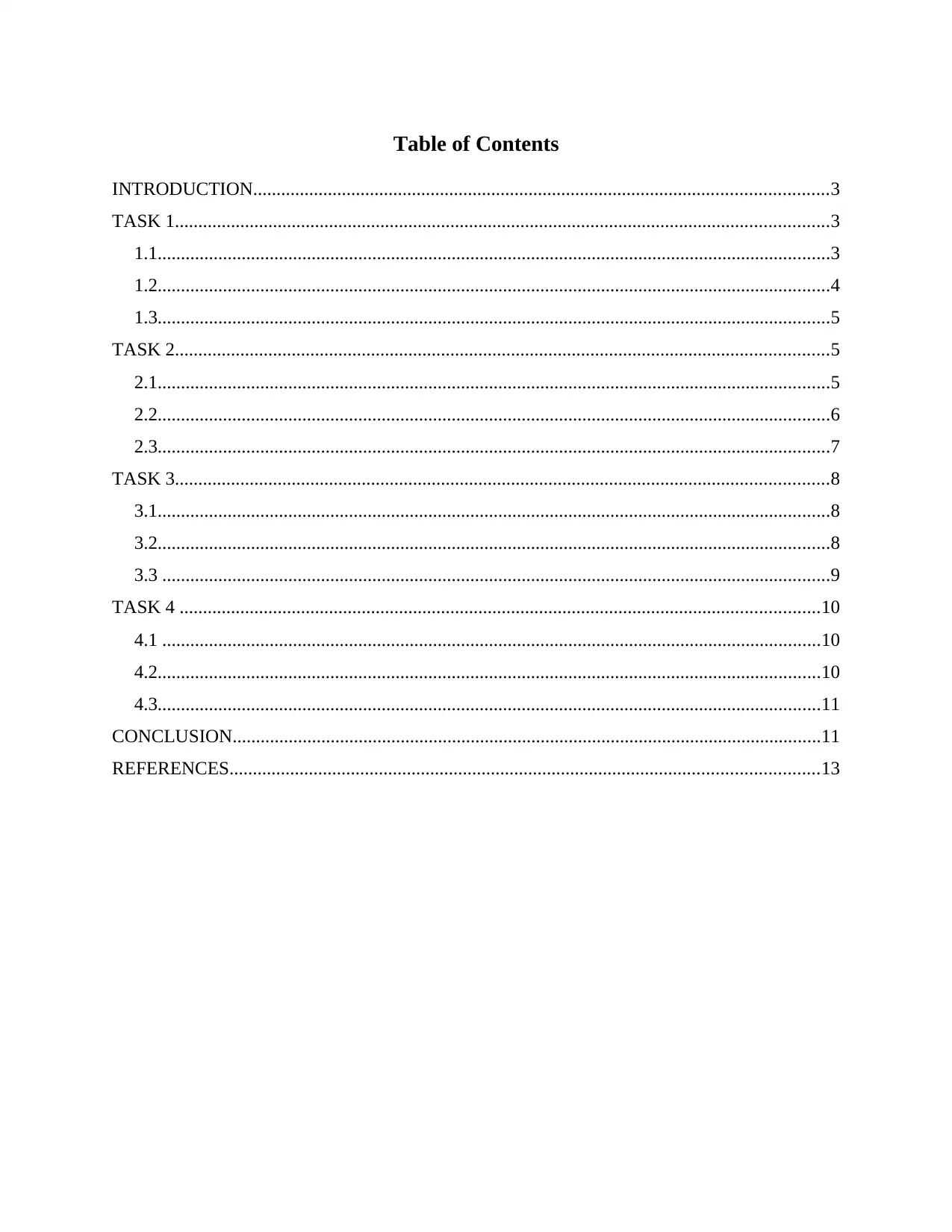
Table of Contents
INTRODUCTION...........................................................................................................................3
TASK 1............................................................................................................................................3
1.1................................................................................................................................................3
1.2................................................................................................................................................4
1.3................................................................................................................................................5
TASK 2............................................................................................................................................5
2.1................................................................................................................................................5
2.2................................................................................................................................................6
2.3................................................................................................................................................7
TASK 3............................................................................................................................................8
3.1................................................................................................................................................8
3.2................................................................................................................................................8
3.3 ...............................................................................................................................................9
TASK 4 .........................................................................................................................................10
4.1 .............................................................................................................................................10
4.2..............................................................................................................................................10
4.3..............................................................................................................................................11
CONCLUSION..............................................................................................................................11
REFERENCES..............................................................................................................................13
INTRODUCTION...........................................................................................................................3
TASK 1............................................................................................................................................3
1.1................................................................................................................................................3
1.2................................................................................................................................................4
1.3................................................................................................................................................5
TASK 2............................................................................................................................................5
2.1................................................................................................................................................5
2.2................................................................................................................................................6
2.3................................................................................................................................................7
TASK 3............................................................................................................................................8
3.1................................................................................................................................................8
3.2................................................................................................................................................8
3.3 ...............................................................................................................................................9
TASK 4 .........................................................................................................................................10
4.1 .............................................................................................................................................10
4.2..............................................................................................................................................10
4.3..............................................................................................................................................11
CONCLUSION..............................................................................................................................11
REFERENCES..............................................................................................................................13
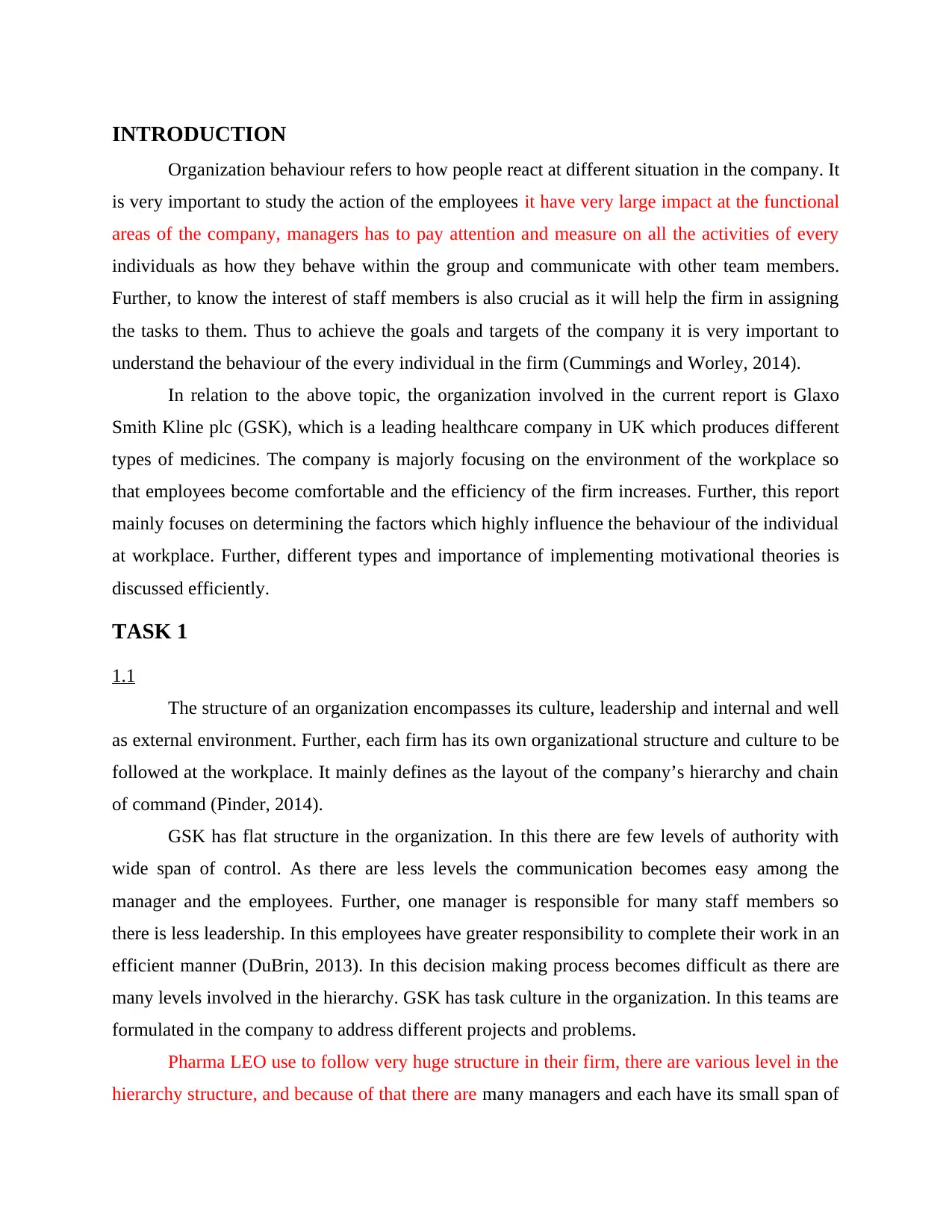
INTRODUCTION
Organization behaviour refers to how people react at different situation in the company. It
is very important to study the action of the employees it have very large impact at the functional
areas of the company, managers has to pay attention and measure on all the activities of every
individuals as how they behave within the group and communicate with other team members.
Further, to know the interest of staff members is also crucial as it will help the firm in assigning
the tasks to them. Thus to achieve the goals and targets of the company it is very important to
understand the behaviour of the every individual in the firm (Cummings and Worley, 2014).
In relation to the above topic, the organization involved in the current report is Glaxo
Smith Kline plc (GSK), which is a leading healthcare company in UK which produces different
types of medicines. The company is majorly focusing on the environment of the workplace so
that employees become comfortable and the efficiency of the firm increases. Further, this report
mainly focuses on determining the factors which highly influence the behaviour of the individual
at workplace. Further, different types and importance of implementing motivational theories is
discussed efficiently.
TASK 1
1.1
The structure of an organization encompasses its culture, leadership and internal and well
as external environment. Further, each firm has its own organizational structure and culture to be
followed at the workplace. It mainly defines as the layout of the company’s hierarchy and chain
of command (Pinder, 2014).
GSK has flat structure in the organization. In this there are few levels of authority with
wide span of control. As there are less levels the communication becomes easy among the
manager and the employees. Further, one manager is responsible for many staff members so
there is less leadership. In this employees have greater responsibility to complete their work in an
efficient manner (DuBrin, 2013). In this decision making process becomes difficult as there are
many levels involved in the hierarchy. GSK has task culture in the organization. In this teams are
formulated in the company to address different projects and problems.
Pharma LEO use to follow very huge structure in their firm, there are various level in the
hierarchy structure, and because of that there are many managers and each have its small span of
Organization behaviour refers to how people react at different situation in the company. It
is very important to study the action of the employees it have very large impact at the functional
areas of the company, managers has to pay attention and measure on all the activities of every
individuals as how they behave within the group and communicate with other team members.
Further, to know the interest of staff members is also crucial as it will help the firm in assigning
the tasks to them. Thus to achieve the goals and targets of the company it is very important to
understand the behaviour of the every individual in the firm (Cummings and Worley, 2014).
In relation to the above topic, the organization involved in the current report is Glaxo
Smith Kline plc (GSK), which is a leading healthcare company in UK which produces different
types of medicines. The company is majorly focusing on the environment of the workplace so
that employees become comfortable and the efficiency of the firm increases. Further, this report
mainly focuses on determining the factors which highly influence the behaviour of the individual
at workplace. Further, different types and importance of implementing motivational theories is
discussed efficiently.
TASK 1
1.1
The structure of an organization encompasses its culture, leadership and internal and well
as external environment. Further, each firm has its own organizational structure and culture to be
followed at the workplace. It mainly defines as the layout of the company’s hierarchy and chain
of command (Pinder, 2014).
GSK has flat structure in the organization. In this there are few levels of authority with
wide span of control. As there are less levels the communication becomes easy among the
manager and the employees. Further, one manager is responsible for many staff members so
there is less leadership. In this employees have greater responsibility to complete their work in an
efficient manner (DuBrin, 2013). In this decision making process becomes difficult as there are
many levels involved in the hierarchy. GSK has task culture in the organization. In this teams are
formulated in the company to address different projects and problems.
Pharma LEO use to follow very huge structure in their firm, there are various level in the
hierarchy structure, and because of that there are many managers and each have its small span of
⊘ This is a preview!⊘
Do you want full access?
Subscribe today to unlock all pages.

Trusted by 1+ million students worldwide
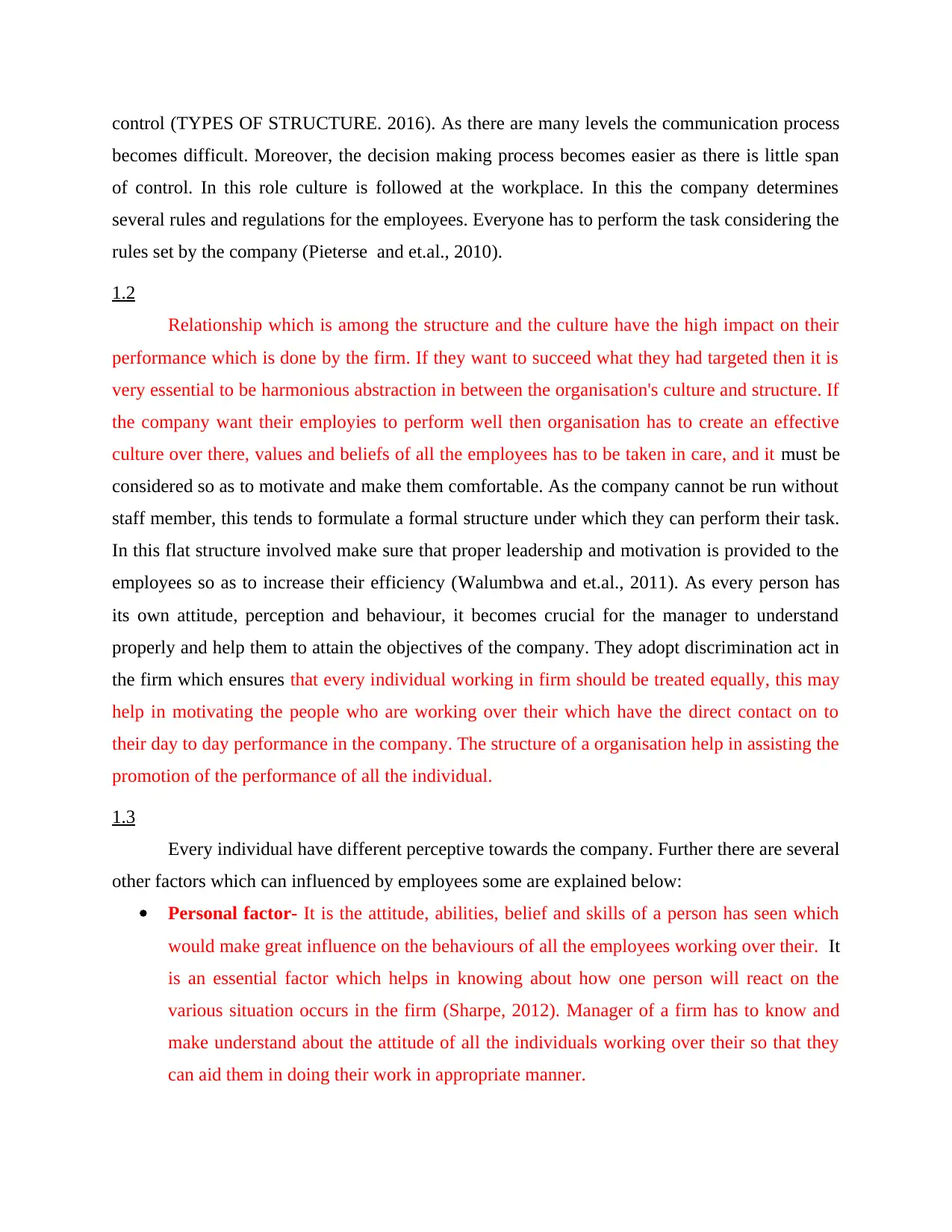
control (TYPES OF STRUCTURE. 2016). As there are many levels the communication process
becomes difficult. Moreover, the decision making process becomes easier as there is little span
of control. In this role culture is followed at the workplace. In this the company determines
several rules and regulations for the employees. Everyone has to perform the task considering the
rules set by the company (Pieterse and et.al., 2010).
1.2
Relationship which is among the structure and the culture have the high impact on their
performance which is done by the firm. If they want to succeed what they had targeted then it is
very essential to be harmonious abstraction in between the organisation's culture and structure. If
the company want their employies to perform well then organisation has to create an effective
culture over there, values and beliefs of all the employees has to be taken in care, and it must be
considered so as to motivate and make them comfortable. As the company cannot be run without
staff member, this tends to formulate a formal structure under which they can perform their task.
In this flat structure involved make sure that proper leadership and motivation is provided to the
employees so as to increase their efficiency (Walumbwa and et.al., 2011). As every person has
its own attitude, perception and behaviour, it becomes crucial for the manager to understand
properly and help them to attain the objectives of the company. They adopt discrimination act in
the firm which ensures that every individual working in firm should be treated equally, this may
help in motivating the people who are working over their which have the direct contact on to
their day to day performance in the company. The structure of a organisation help in assisting the
promotion of the performance of all the individual.
1.3
Every individual have different perceptive towards the company. Further there are several
other factors which can influenced by employees some are explained below:
Personal factor- It is the attitude, abilities, belief and skills of a person has seen which
would make great influence on the behaviours of all the employees working over their. It
is an essential factor which helps in knowing about how one person will react on the
various situation occurs in the firm (Sharpe, 2012). Manager of a firm has to know and
make understand about the attitude of all the individuals working over their so that they
can aid them in doing their work in appropriate manner.
becomes difficult. Moreover, the decision making process becomes easier as there is little span
of control. In this role culture is followed at the workplace. In this the company determines
several rules and regulations for the employees. Everyone has to perform the task considering the
rules set by the company (Pieterse and et.al., 2010).
1.2
Relationship which is among the structure and the culture have the high impact on their
performance which is done by the firm. If they want to succeed what they had targeted then it is
very essential to be harmonious abstraction in between the organisation's culture and structure. If
the company want their employies to perform well then organisation has to create an effective
culture over there, values and beliefs of all the employees has to be taken in care, and it must be
considered so as to motivate and make them comfortable. As the company cannot be run without
staff member, this tends to formulate a formal structure under which they can perform their task.
In this flat structure involved make sure that proper leadership and motivation is provided to the
employees so as to increase their efficiency (Walumbwa and et.al., 2011). As every person has
its own attitude, perception and behaviour, it becomes crucial for the manager to understand
properly and help them to attain the objectives of the company. They adopt discrimination act in
the firm which ensures that every individual working in firm should be treated equally, this may
help in motivating the people who are working over their which have the direct contact on to
their day to day performance in the company. The structure of a organisation help in assisting the
promotion of the performance of all the individual.
1.3
Every individual have different perceptive towards the company. Further there are several
other factors which can influenced by employees some are explained below:
Personal factor- It is the attitude, abilities, belief and skills of a person has seen which
would make great influence on the behaviours of all the employees working over their. It
is an essential factor which helps in knowing about how one person will react on the
various situation occurs in the firm (Sharpe, 2012). Manager of a firm has to know and
make understand about the attitude of all the individuals working over their so that they
can aid them in doing their work in appropriate manner.
Paraphrase This Document
Need a fresh take? Get an instant paraphrase of this document with our AI Paraphraser
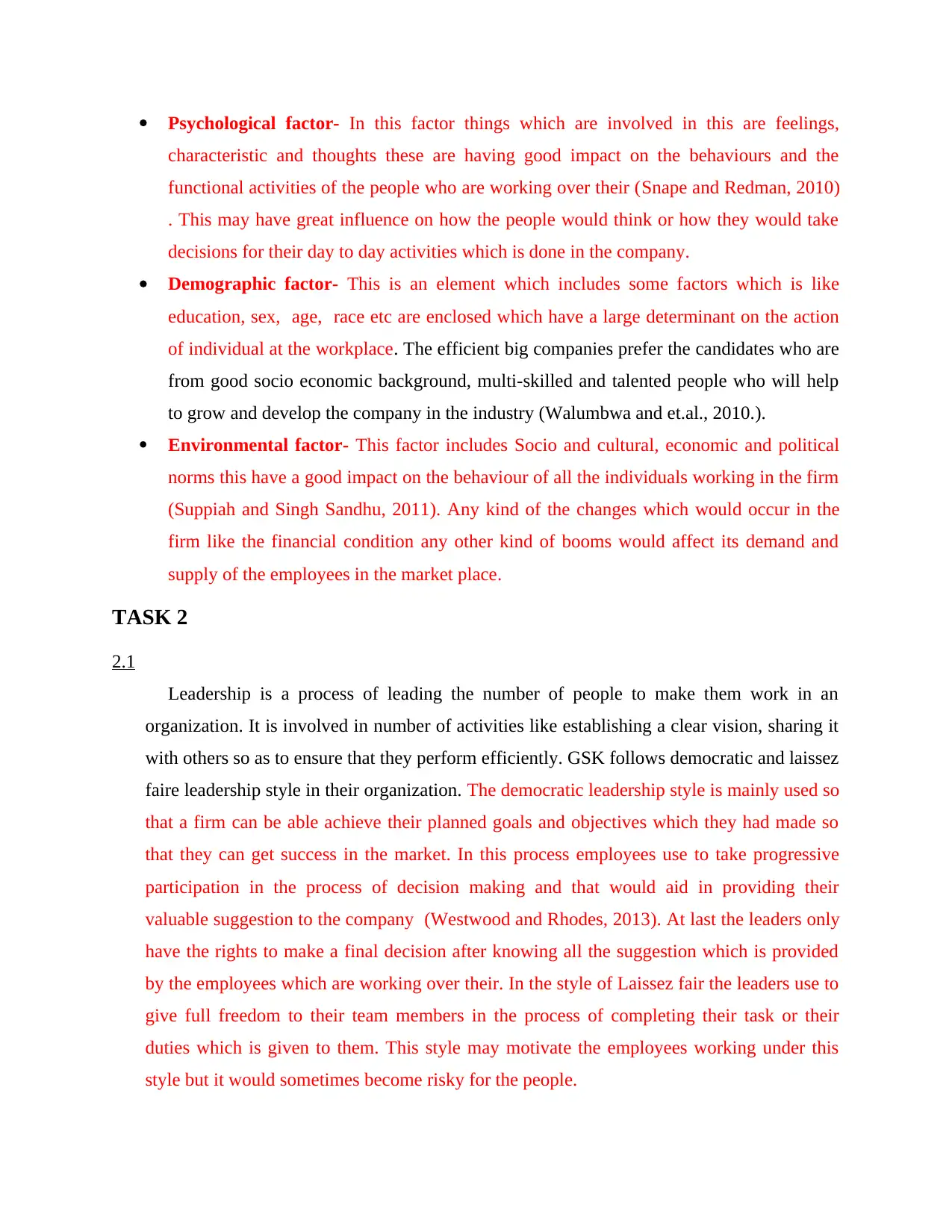
Psychological factor- In this factor things which are involved in this are feelings,
characteristic and thoughts these are having good impact on the behaviours and the
functional activities of the people who are working over their (Snape and Redman, 2010)
. This may have great influence on how the people would think or how they would take
decisions for their day to day activities which is done in the company.
Demographic factor- This is an element which includes some factors which is like
education, sex, age, race etc are enclosed which have a large determinant on the action
of individual at the workplace. The efficient big companies prefer the candidates who are
from good socio economic background, multi-skilled and talented people who will help
to grow and develop the company in the industry (Walumbwa and et.al., 2010.).
Environmental factor- This factor includes Socio and cultural, economic and political
norms this have a good impact on the behaviour of all the individuals working in the firm
(Suppiah and Singh Sandhu, 2011). Any kind of the changes which would occur in the
firm like the financial condition any other kind of booms would affect its demand and
supply of the employees in the market place.
TASK 2
2.1
Leadership is a process of leading the number of people to make them work in an
organization. It is involved in number of activities like establishing a clear vision, sharing it
with others so as to ensure that they perform efficiently. GSK follows democratic and laissez
faire leadership style in their organization. The democratic leadership style is mainly used so
that a firm can be able achieve their planned goals and objectives which they had made so
that they can get success in the market. In this process employees use to take progressive
participation in the process of decision making and that would aid in providing their
valuable suggestion to the company (Westwood and Rhodes, 2013). At last the leaders only
have the rights to make a final decision after knowing all the suggestion which is provided
by the employees which are working over their. In the style of Laissez fair the leaders use to
give full freedom to their team members in the process of completing their task or their
duties which is given to them. This style may motivate the employees working under this
style but it would sometimes become risky for the people.
characteristic and thoughts these are having good impact on the behaviours and the
functional activities of the people who are working over their (Snape and Redman, 2010)
. This may have great influence on how the people would think or how they would take
decisions for their day to day activities which is done in the company.
Demographic factor- This is an element which includes some factors which is like
education, sex, age, race etc are enclosed which have a large determinant on the action
of individual at the workplace. The efficient big companies prefer the candidates who are
from good socio economic background, multi-skilled and talented people who will help
to grow and develop the company in the industry (Walumbwa and et.al., 2010.).
Environmental factor- This factor includes Socio and cultural, economic and political
norms this have a good impact on the behaviour of all the individuals working in the firm
(Suppiah and Singh Sandhu, 2011). Any kind of the changes which would occur in the
firm like the financial condition any other kind of booms would affect its demand and
supply of the employees in the market place.
TASK 2
2.1
Leadership is a process of leading the number of people to make them work in an
organization. It is involved in number of activities like establishing a clear vision, sharing it
with others so as to ensure that they perform efficiently. GSK follows democratic and laissez
faire leadership style in their organization. The democratic leadership style is mainly used so
that a firm can be able achieve their planned goals and objectives which they had made so
that they can get success in the market. In this process employees use to take progressive
participation in the process of decision making and that would aid in providing their
valuable suggestion to the company (Westwood and Rhodes, 2013). At last the leaders only
have the rights to make a final decision after knowing all the suggestion which is provided
by the employees which are working over their. In the style of Laissez fair the leaders use to
give full freedom to their team members in the process of completing their task or their
duties which is given to them. This style may motivate the employees working under this
style but it would sometimes become risky for the people.
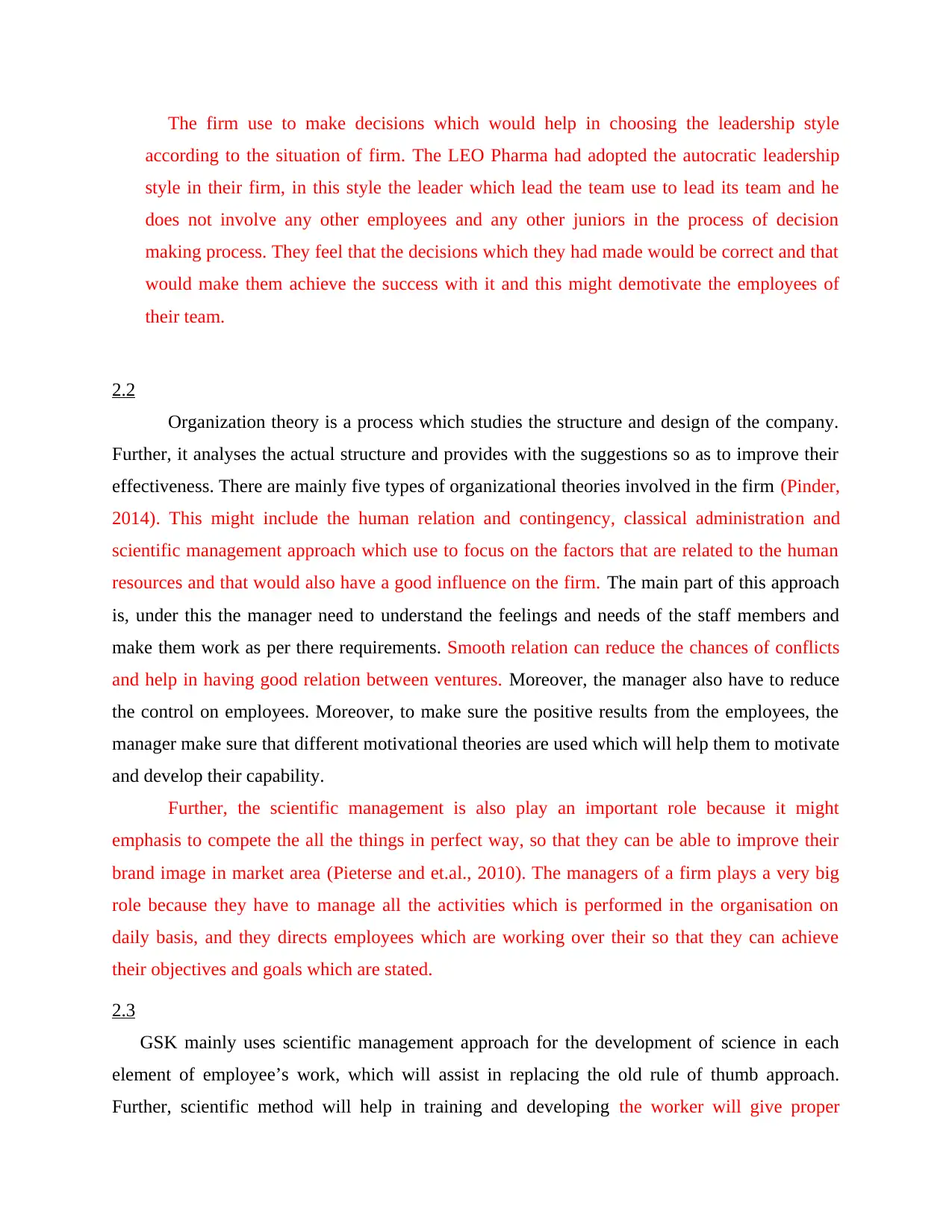
The firm use to make decisions which would help in choosing the leadership style
according to the situation of firm. The LEO Pharma had adopted the autocratic leadership
style in their firm, in this style the leader which lead the team use to lead its team and he
does not involve any other employees and any other juniors in the process of decision
making process. They feel that the decisions which they had made would be correct and that
would make them achieve the success with it and this might demotivate the employees of
their team.
2.2
Organization theory is a process which studies the structure and design of the company.
Further, it analyses the actual structure and provides with the suggestions so as to improve their
effectiveness. There are mainly five types of organizational theories involved in the firm (Pinder,
2014). This might include the human relation and contingency, classical administration and
scientific management approach which use to focus on the factors that are related to the human
resources and that would also have a good influence on the firm. The main part of this approach
is, under this the manager need to understand the feelings and needs of the staff members and
make them work as per there requirements. Smooth relation can reduce the chances of conflicts
and help in having good relation between ventures. Moreover, the manager also have to reduce
the control on employees. Moreover, to make sure the positive results from the employees, the
manager make sure that different motivational theories are used which will help them to motivate
and develop their capability.
Further, the scientific management is also play an important role because it might
emphasis to compete the all the things in perfect way, so that they can be able to improve their
brand image in market area (Pieterse and et.al., 2010). The managers of a firm plays a very big
role because they have to manage all the activities which is performed in the organisation on
daily basis, and they directs employees which are working over their so that they can achieve
their objectives and goals which are stated.
2.3
GSK mainly uses scientific management approach for the development of science in each
element of employee’s work, which will assist in replacing the old rule of thumb approach.
Further, scientific method will help in training and developing the worker will give proper
according to the situation of firm. The LEO Pharma had adopted the autocratic leadership
style in their firm, in this style the leader which lead the team use to lead its team and he
does not involve any other employees and any other juniors in the process of decision
making process. They feel that the decisions which they had made would be correct and that
would make them achieve the success with it and this might demotivate the employees of
their team.
2.2
Organization theory is a process which studies the structure and design of the company.
Further, it analyses the actual structure and provides with the suggestions so as to improve their
effectiveness. There are mainly five types of organizational theories involved in the firm (Pinder,
2014). This might include the human relation and contingency, classical administration and
scientific management approach which use to focus on the factors that are related to the human
resources and that would also have a good influence on the firm. The main part of this approach
is, under this the manager need to understand the feelings and needs of the staff members and
make them work as per there requirements. Smooth relation can reduce the chances of conflicts
and help in having good relation between ventures. Moreover, the manager also have to reduce
the control on employees. Moreover, to make sure the positive results from the employees, the
manager make sure that different motivational theories are used which will help them to motivate
and develop their capability.
Further, the scientific management is also play an important role because it might
emphasis to compete the all the things in perfect way, so that they can be able to improve their
brand image in market area (Pieterse and et.al., 2010). The managers of a firm plays a very big
role because they have to manage all the activities which is performed in the organisation on
daily basis, and they directs employees which are working over their so that they can achieve
their objectives and goals which are stated.
2.3
GSK mainly uses scientific management approach for the development of science in each
element of employee’s work, which will assist in replacing the old rule of thumb approach.
Further, scientific method will help in training and developing the worker will give proper
⊘ This is a preview!⊘
Do you want full access?
Subscribe today to unlock all pages.

Trusted by 1+ million students worldwide
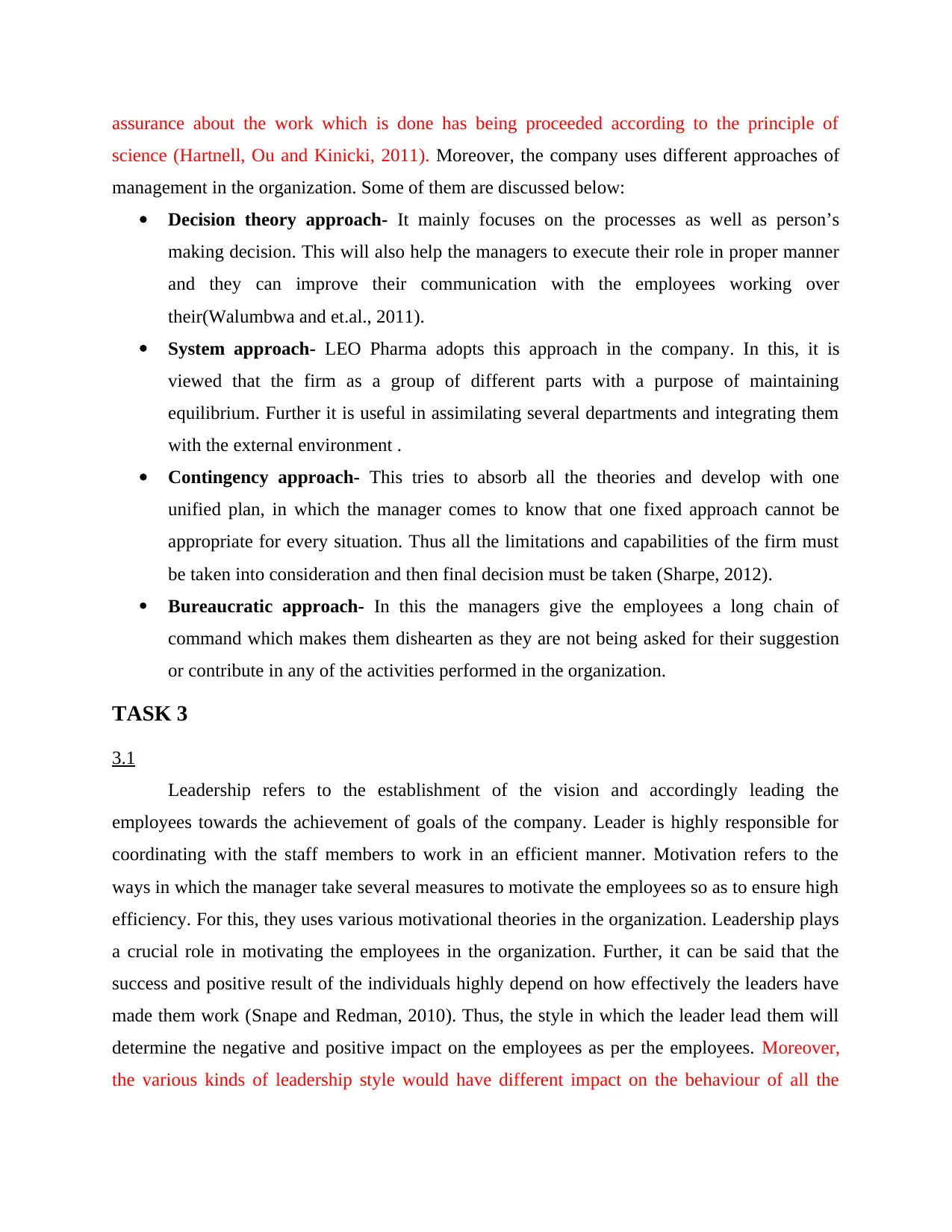
assurance about the work which is done has being proceeded according to the principle of
science (Hartnell, Ou and Kinicki, 2011). Moreover, the company uses different approaches of
management in the organization. Some of them are discussed below:
Decision theory approach- It mainly focuses on the processes as well as person’s
making decision. This will also help the managers to execute their role in proper manner
and they can improve their communication with the employees working over
their(Walumbwa and et.al., 2011).
System approach- LEO Pharma adopts this approach in the company. In this, it is
viewed that the firm as a group of different parts with a purpose of maintaining
equilibrium. Further it is useful in assimilating several departments and integrating them
with the external environment .
Contingency approach- This tries to absorb all the theories and develop with one
unified plan, in which the manager comes to know that one fixed approach cannot be
appropriate for every situation. Thus all the limitations and capabilities of the firm must
be taken into consideration and then final decision must be taken (Sharpe, 2012).
Bureaucratic approach- In this the managers give the employees a long chain of
command which makes them dishearten as they are not being asked for their suggestion
or contribute in any of the activities performed in the organization.
TASK 3
3.1
Leadership refers to the establishment of the vision and accordingly leading the
employees towards the achievement of goals of the company. Leader is highly responsible for
coordinating with the staff members to work in an efficient manner. Motivation refers to the
ways in which the manager take several measures to motivate the employees so as to ensure high
efficiency. For this, they uses various motivational theories in the organization. Leadership plays
a crucial role in motivating the employees in the organization. Further, it can be said that the
success and positive result of the individuals highly depend on how effectively the leaders have
made them work (Snape and Redman, 2010). Thus, the style in which the leader lead them will
determine the negative and positive impact on the employees as per the employees. Moreover,
the various kinds of leadership style would have different impact on the behaviour of all the
science (Hartnell, Ou and Kinicki, 2011). Moreover, the company uses different approaches of
management in the organization. Some of them are discussed below:
Decision theory approach- It mainly focuses on the processes as well as person’s
making decision. This will also help the managers to execute their role in proper manner
and they can improve their communication with the employees working over
their(Walumbwa and et.al., 2011).
System approach- LEO Pharma adopts this approach in the company. In this, it is
viewed that the firm as a group of different parts with a purpose of maintaining
equilibrium. Further it is useful in assimilating several departments and integrating them
with the external environment .
Contingency approach- This tries to absorb all the theories and develop with one
unified plan, in which the manager comes to know that one fixed approach cannot be
appropriate for every situation. Thus all the limitations and capabilities of the firm must
be taken into consideration and then final decision must be taken (Sharpe, 2012).
Bureaucratic approach- In this the managers give the employees a long chain of
command which makes them dishearten as they are not being asked for their suggestion
or contribute in any of the activities performed in the organization.
TASK 3
3.1
Leadership refers to the establishment of the vision and accordingly leading the
employees towards the achievement of goals of the company. Leader is highly responsible for
coordinating with the staff members to work in an efficient manner. Motivation refers to the
ways in which the manager take several measures to motivate the employees so as to ensure high
efficiency. For this, they uses various motivational theories in the organization. Leadership plays
a crucial role in motivating the employees in the organization. Further, it can be said that the
success and positive result of the individuals highly depend on how effectively the leaders have
made them work (Snape and Redman, 2010). Thus, the style in which the leader lead them will
determine the negative and positive impact on the employees as per the employees. Moreover,
the various kinds of leadership style would have different impact on the behaviour of all the
Paraphrase This Document
Need a fresh take? Get an instant paraphrase of this document with our AI Paraphraser
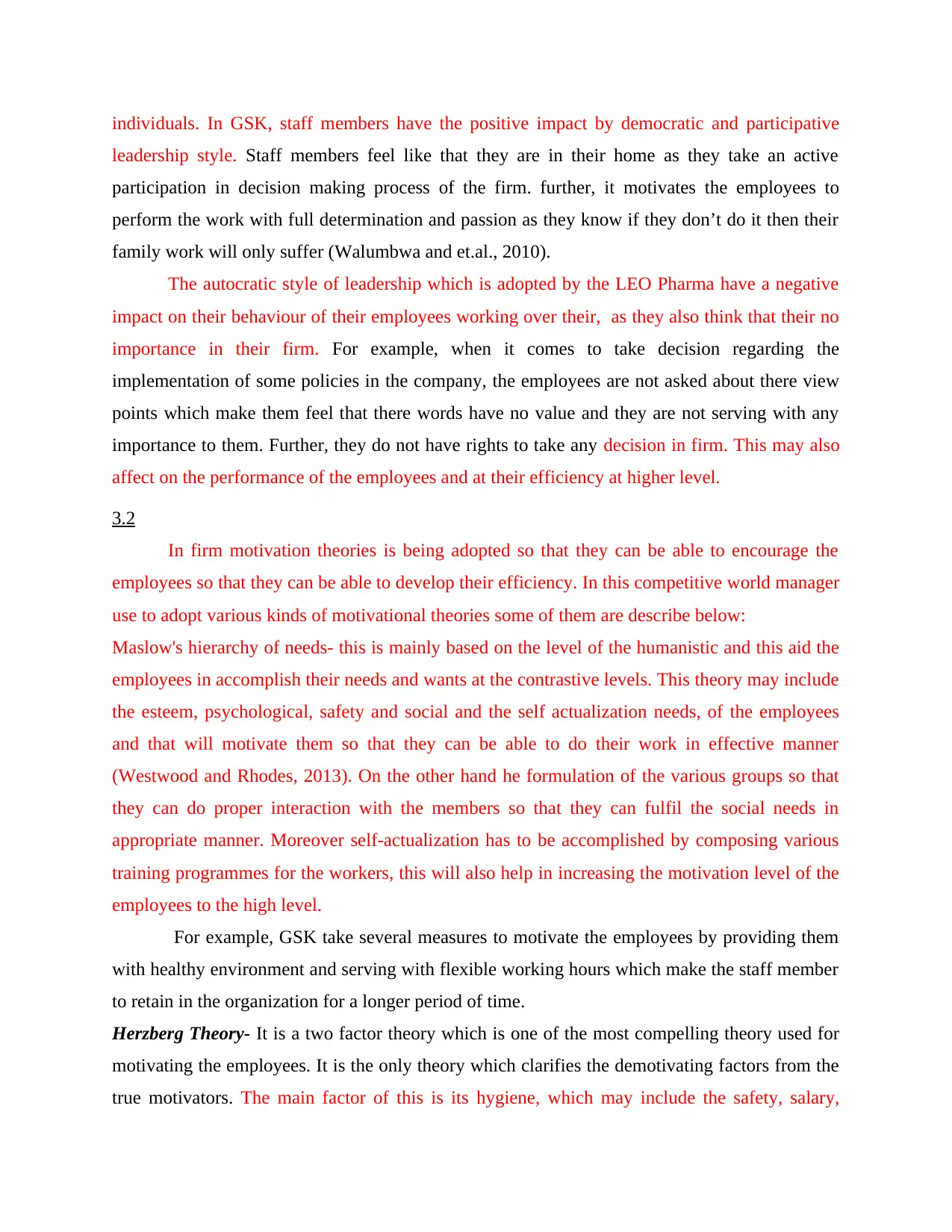
individuals. In GSK, staff members have the positive impact by democratic and participative
leadership style. Staff members feel like that they are in their home as they take an active
participation in decision making process of the firm. further, it motivates the employees to
perform the work with full determination and passion as they know if they don’t do it then their
family work will only suffer (Walumbwa and et.al., 2010).
The autocratic style of leadership which is adopted by the LEO Pharma have a negative
impact on their behaviour of their employees working over their, as they also think that their no
importance in their firm. For example, when it comes to take decision regarding the
implementation of some policies in the company, the employees are not asked about there view
points which make them feel that there words have no value and they are not serving with any
importance to them. Further, they do not have rights to take any decision in firm. This may also
affect on the performance of the employees and at their efficiency at higher level.
3.2
In firm motivation theories is being adopted so that they can be able to encourage the
employees so that they can be able to develop their efficiency. In this competitive world manager
use to adopt various kinds of motivational theories some of them are describe below:
Maslow's hierarchy of needs- this is mainly based on the level of the humanistic and this aid the
employees in accomplish their needs and wants at the contrastive levels. This theory may include
the esteem, psychological, safety and social and the self actualization needs, of the employees
and that will motivate them so that they can be able to do their work in effective manner
(Westwood and Rhodes, 2013). On the other hand he formulation of the various groups so that
they can do proper interaction with the members so that they can fulfil the social needs in
appropriate manner. Moreover self-actualization has to be accomplished by composing various
training programmes for the workers, this will also help in increasing the motivation level of the
employees to the high level.
For example, GSK take several measures to motivate the employees by providing them
with healthy environment and serving with flexible working hours which make the staff member
to retain in the organization for a longer period of time.
Herzberg Theory- It is a two factor theory which is one of the most compelling theory used for
motivating the employees. It is the only theory which clarifies the demotivating factors from the
true motivators. The main factor of this is its hygiene, which may include the safety, salary,
leadership style. Staff members feel like that they are in their home as they take an active
participation in decision making process of the firm. further, it motivates the employees to
perform the work with full determination and passion as they know if they don’t do it then their
family work will only suffer (Walumbwa and et.al., 2010).
The autocratic style of leadership which is adopted by the LEO Pharma have a negative
impact on their behaviour of their employees working over their, as they also think that their no
importance in their firm. For example, when it comes to take decision regarding the
implementation of some policies in the company, the employees are not asked about there view
points which make them feel that there words have no value and they are not serving with any
importance to them. Further, they do not have rights to take any decision in firm. This may also
affect on the performance of the employees and at their efficiency at higher level.
3.2
In firm motivation theories is being adopted so that they can be able to encourage the
employees so that they can be able to develop their efficiency. In this competitive world manager
use to adopt various kinds of motivational theories some of them are describe below:
Maslow's hierarchy of needs- this is mainly based on the level of the humanistic and this aid the
employees in accomplish their needs and wants at the contrastive levels. This theory may include
the esteem, psychological, safety and social and the self actualization needs, of the employees
and that will motivate them so that they can be able to do their work in effective manner
(Westwood and Rhodes, 2013). On the other hand he formulation of the various groups so that
they can do proper interaction with the members so that they can fulfil the social needs in
appropriate manner. Moreover self-actualization has to be accomplished by composing various
training programmes for the workers, this will also help in increasing the motivation level of the
employees to the high level.
For example, GSK take several measures to motivate the employees by providing them
with healthy environment and serving with flexible working hours which make the staff member
to retain in the organization for a longer period of time.
Herzberg Theory- It is a two factor theory which is one of the most compelling theory used for
motivating the employees. It is the only theory which clarifies the demotivating factors from the
true motivators. The main factor of this is its hygiene, which may include the safety, salary,
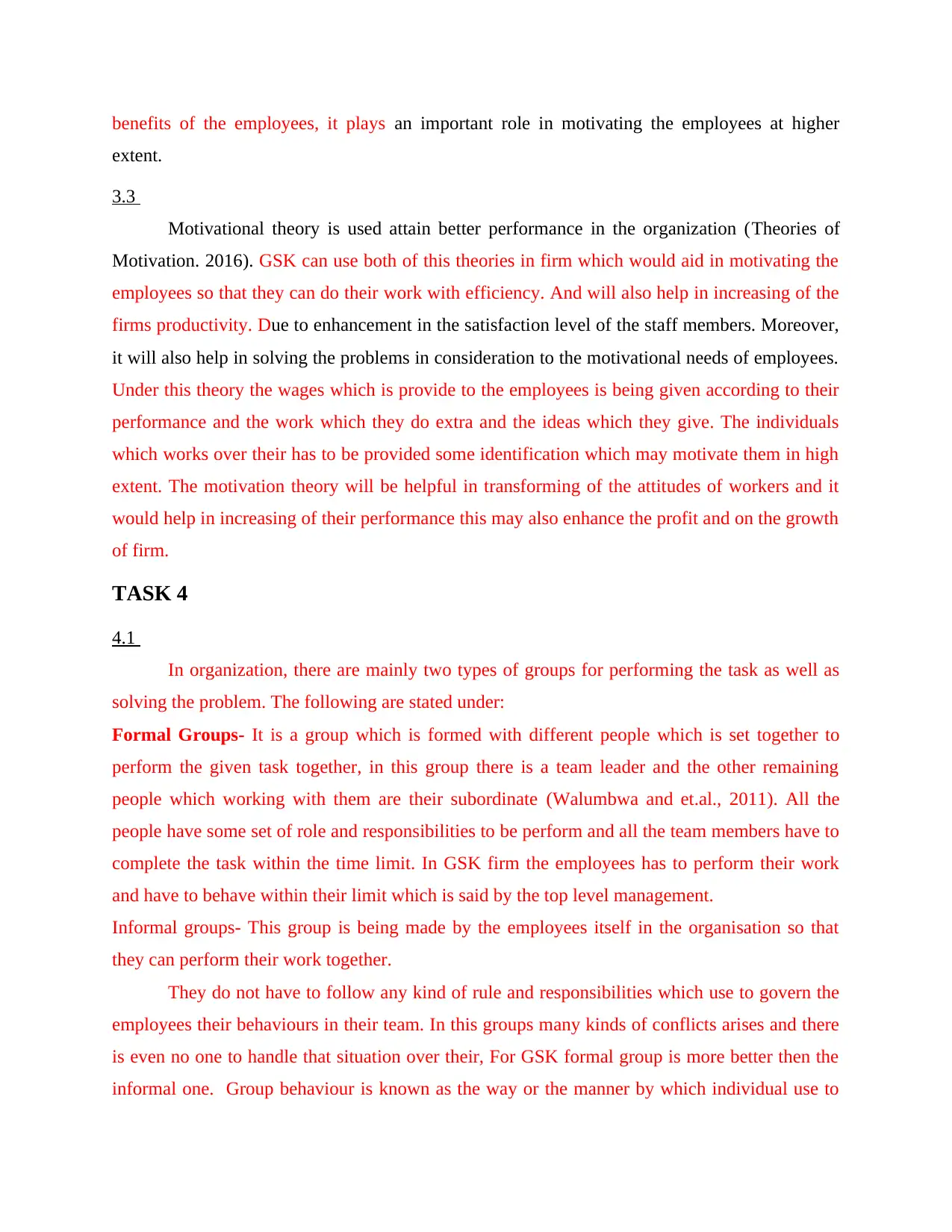
benefits of the employees, it plays an important role in motivating the employees at higher
extent.
3.3
Motivational theory is used attain better performance in the organization (Theories of
Motivation. 2016). GSK can use both of this theories in firm which would aid in motivating the
employees so that they can do their work with efficiency. And will also help in increasing of the
firms productivity. Due to enhancement in the satisfaction level of the staff members. Moreover,
it will also help in solving the problems in consideration to the motivational needs of employees.
Under this theory the wages which is provide to the employees is being given according to their
performance and the work which they do extra and the ideas which they give. The individuals
which works over their has to be provided some identification which may motivate them in high
extent. The motivation theory will be helpful in transforming of the attitudes of workers and it
would help in increasing of their performance this may also enhance the profit and on the growth
of firm.
TASK 4
4.1
In organization, there are mainly two types of groups for performing the task as well as
solving the problem. The following are stated under:
Formal Groups- It is a group which is formed with different people which is set together to
perform the given task together, in this group there is a team leader and the other remaining
people which working with them are their subordinate (Walumbwa and et.al., 2011). All the
people have some set of role and responsibilities to be perform and all the team members have to
complete the task within the time limit. In GSK firm the employees has to perform their work
and have to behave within their limit which is said by the top level management.
Informal groups- This group is being made by the employees itself in the organisation so that
they can perform their work together.
They do not have to follow any kind of rule and responsibilities which use to govern the
employees their behaviours in their team. In this groups many kinds of conflicts arises and there
is even no one to handle that situation over their, For GSK formal group is more better then the
informal one. Group behaviour is known as the way or the manner by which individual use to
extent.
3.3
Motivational theory is used attain better performance in the organization (Theories of
Motivation. 2016). GSK can use both of this theories in firm which would aid in motivating the
employees so that they can do their work with efficiency. And will also help in increasing of the
firms productivity. Due to enhancement in the satisfaction level of the staff members. Moreover,
it will also help in solving the problems in consideration to the motivational needs of employees.
Under this theory the wages which is provide to the employees is being given according to their
performance and the work which they do extra and the ideas which they give. The individuals
which works over their has to be provided some identification which may motivate them in high
extent. The motivation theory will be helpful in transforming of the attitudes of workers and it
would help in increasing of their performance this may also enhance the profit and on the growth
of firm.
TASK 4
4.1
In organization, there are mainly two types of groups for performing the task as well as
solving the problem. The following are stated under:
Formal Groups- It is a group which is formed with different people which is set together to
perform the given task together, in this group there is a team leader and the other remaining
people which working with them are their subordinate (Walumbwa and et.al., 2011). All the
people have some set of role and responsibilities to be perform and all the team members have to
complete the task within the time limit. In GSK firm the employees has to perform their work
and have to behave within their limit which is said by the top level management.
Informal groups- This group is being made by the employees itself in the organisation so that
they can perform their work together.
They do not have to follow any kind of rule and responsibilities which use to govern the
employees their behaviours in their team. In this groups many kinds of conflicts arises and there
is even no one to handle that situation over their, For GSK formal group is more better then the
informal one. Group behaviour is known as the way or the manner by which individual use to
⊘ This is a preview!⊘
Do you want full access?
Subscribe today to unlock all pages.

Trusted by 1+ million students worldwide
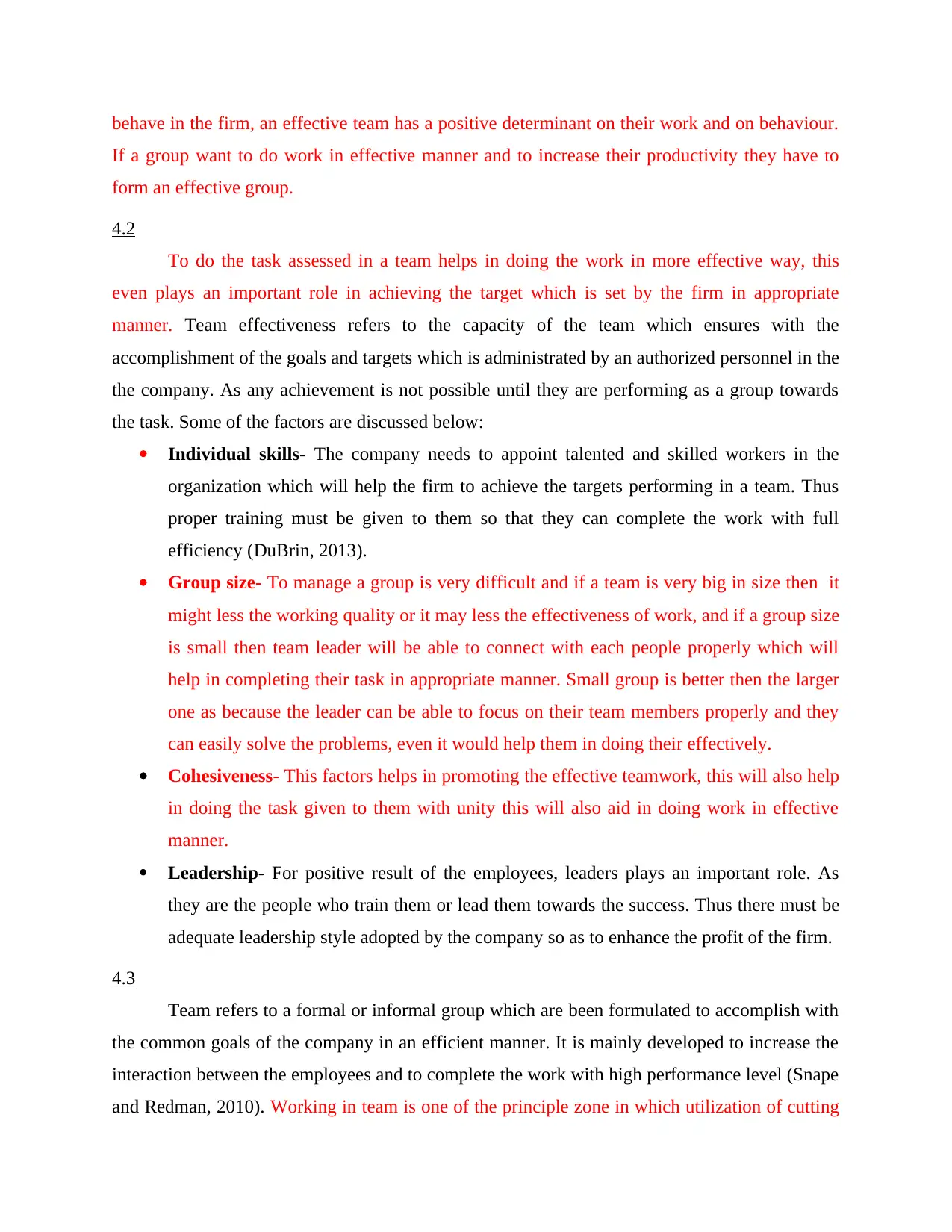
behave in the firm, an effective team has a positive determinant on their work and on behaviour.
If a group want to do work in effective manner and to increase their productivity they have to
form an effective group.
4.2
To do the task assessed in a team helps in doing the work in more effective way, this
even plays an important role in achieving the target which is set by the firm in appropriate
manner. Team effectiveness refers to the capacity of the team which ensures with the
accomplishment of the goals and targets which is administrated by an authorized personnel in the
the company. As any achievement is not possible until they are performing as a group towards
the task. Some of the factors are discussed below:
Individual skills- The company needs to appoint talented and skilled workers in the
organization which will help the firm to achieve the targets performing in a team. Thus
proper training must be given to them so that they can complete the work with full
efficiency (DuBrin, 2013).
Group size- To manage a group is very difficult and if a team is very big in size then it
might less the working quality or it may less the effectiveness of work, and if a group size
is small then team leader will be able to connect with each people properly which will
help in completing their task in appropriate manner. Small group is better then the larger
one as because the leader can be able to focus on their team members properly and they
can easily solve the problems, even it would help them in doing their effectively.
Cohesiveness- This factors helps in promoting the effective teamwork, this will also help
in doing the task given to them with unity this will also aid in doing work in effective
manner.
Leadership- For positive result of the employees, leaders plays an important role. As
they are the people who train them or lead them towards the success. Thus there must be
adequate leadership style adopted by the company so as to enhance the profit of the firm.
4.3
Team refers to a formal or informal group which are been formulated to accomplish with
the common goals of the company in an efficient manner. It is mainly developed to increase the
interaction between the employees and to complete the work with high performance level (Snape
and Redman, 2010). Working in team is one of the principle zone in which utilization of cutting
If a group want to do work in effective manner and to increase their productivity they have to
form an effective group.
4.2
To do the task assessed in a team helps in doing the work in more effective way, this
even plays an important role in achieving the target which is set by the firm in appropriate
manner. Team effectiveness refers to the capacity of the team which ensures with the
accomplishment of the goals and targets which is administrated by an authorized personnel in the
the company. As any achievement is not possible until they are performing as a group towards
the task. Some of the factors are discussed below:
Individual skills- The company needs to appoint talented and skilled workers in the
organization which will help the firm to achieve the targets performing in a team. Thus
proper training must be given to them so that they can complete the work with full
efficiency (DuBrin, 2013).
Group size- To manage a group is very difficult and if a team is very big in size then it
might less the working quality or it may less the effectiveness of work, and if a group size
is small then team leader will be able to connect with each people properly which will
help in completing their task in appropriate manner. Small group is better then the larger
one as because the leader can be able to focus on their team members properly and they
can easily solve the problems, even it would help them in doing their effectively.
Cohesiveness- This factors helps in promoting the effective teamwork, this will also help
in doing the task given to them with unity this will also aid in doing work in effective
manner.
Leadership- For positive result of the employees, leaders plays an important role. As
they are the people who train them or lead them towards the success. Thus there must be
adequate leadership style adopted by the company so as to enhance the profit of the firm.
4.3
Team refers to a formal or informal group which are been formulated to accomplish with
the common goals of the company in an efficient manner. It is mainly developed to increase the
interaction between the employees and to complete the work with high performance level (Snape
and Redman, 2010). Working in team is one of the principle zone in which utilization of cutting
Paraphrase This Document
Need a fresh take? Get an instant paraphrase of this document with our AI Paraphraser

edge innovation can profit the organization to achieve aggressive edge in the market. GSK
utilizes propelled innovation administrations like Gmail, Skype and different devices are utilized
which help in finishing the work with full productivity and in brief time frame. Hence, utilization
of cutting edge innovation improves group working which likewise advantage an association.
Preparing ought to be given to the group in authentic way so they can perform with higher
productivity. Henceforth, this prompt smooth and compelling working of group in association.
By utilizing innovation colleagues stay in contact with each other even they are working in
various countries. They work and talk together while they are at better places. Thus, one might
say that innovation put a positive effect on group working in GSK.
CONCLUSION
It is been concluded from the above report is that the multifaceted discipline which is a
crucial element in managing the business in an efficient manner. Further, the motivational
theories, leadership styles and other factors highly affect the individual behaviour in the
organization. Moreover, the technologies, group behaviour and teamwork also play an important
role in the development of the company. In addition to this, it is the role of management in
creating the culture and structure of the organization efficiently which help the employees to
work with full determination.
utilizes propelled innovation administrations like Gmail, Skype and different devices are utilized
which help in finishing the work with full productivity and in brief time frame. Hence, utilization
of cutting edge innovation improves group working which likewise advantage an association.
Preparing ought to be given to the group in authentic way so they can perform with higher
productivity. Henceforth, this prompt smooth and compelling working of group in association.
By utilizing innovation colleagues stay in contact with each other even they are working in
various countries. They work and talk together while they are at better places. Thus, one might
say that innovation put a positive effect on group working in GSK.
CONCLUSION
It is been concluded from the above report is that the multifaceted discipline which is a
crucial element in managing the business in an efficient manner. Further, the motivational
theories, leadership styles and other factors highly affect the individual behaviour in the
organization. Moreover, the technologies, group behaviour and teamwork also play an important
role in the development of the company. In addition to this, it is the role of management in
creating the culture and structure of the organization efficiently which help the employees to
work with full determination.
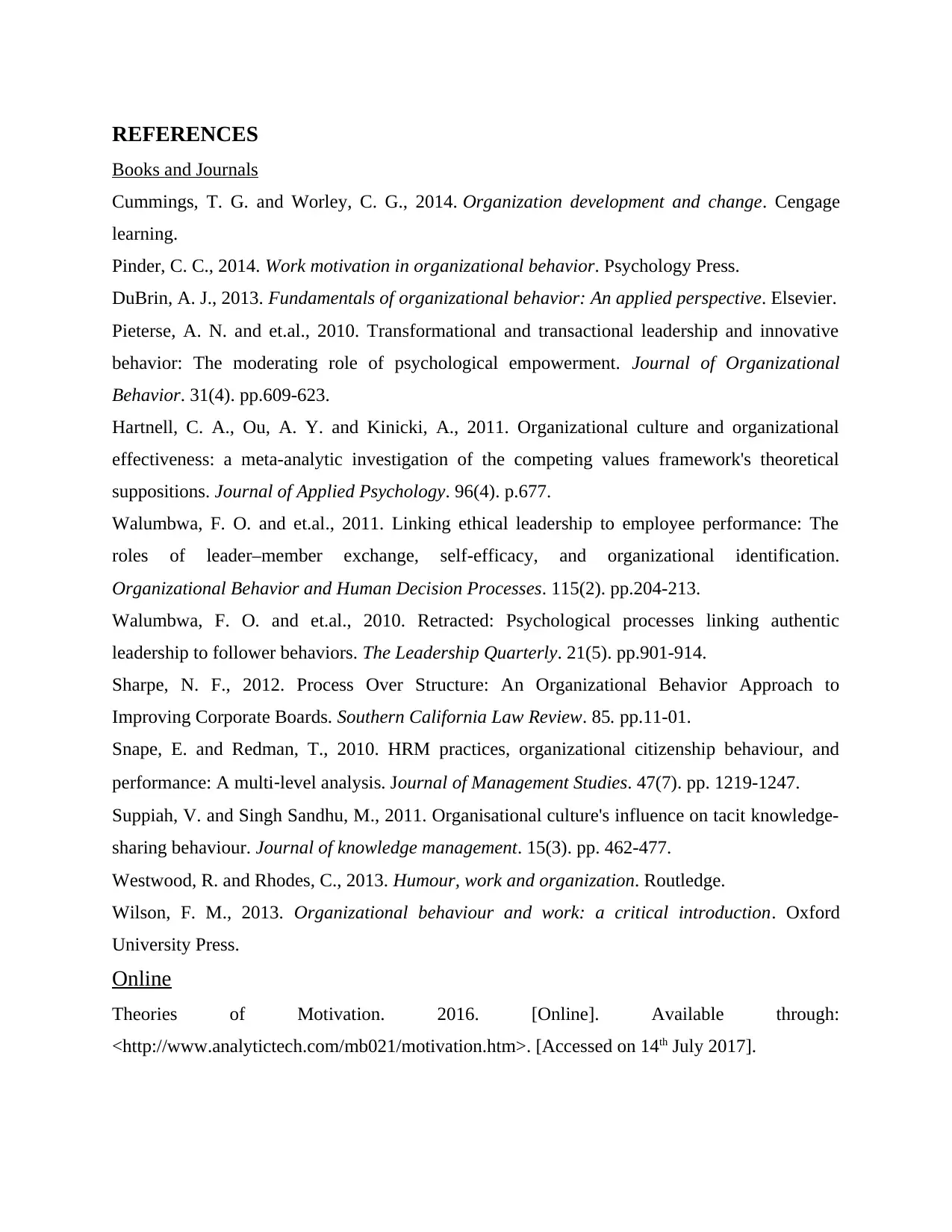
REFERENCES
Books and Journals
Cummings, T. G. and Worley, C. G., 2014. Organization development and change. Cengage
learning.
Pinder, C. C., 2014. Work motivation in organizational behavior. Psychology Press.
DuBrin, A. J., 2013. Fundamentals of organizational behavior: An applied perspective. Elsevier.
Pieterse, A. N. and et.al., 2010. Transformational and transactional leadership and innovative
behavior: The moderating role of psychological empowerment. Journal of Organizational
Behavior. 31(4). pp.609-623.
Hartnell, C. A., Ou, A. Y. and Kinicki, A., 2011. Organizational culture and organizational
effectiveness: a meta-analytic investigation of the competing values framework's theoretical
suppositions. Journal of Applied Psychology. 96(4). p.677.
Walumbwa, F. O. and et.al., 2011. Linking ethical leadership to employee performance: The
roles of leader–member exchange, self-efficacy, and organizational identification.
Organizational Behavior and Human Decision Processes. 115(2). pp.204-213.
Walumbwa, F. O. and et.al., 2010. Retracted: Psychological processes linking authentic
leadership to follower behaviors. The Leadership Quarterly. 21(5). pp.901-914.
Sharpe, N. F., 2012. Process Over Structure: An Organizational Behavior Approach to
Improving Corporate Boards. Southern California Law Review. 85. pp.11-01.
Snape, E. and Redman, T., 2010. HRM practices, organizational citizenship behaviour, and
performance: A multi‐level analysis. Journal of Management Studies. 47(7). pp. 1219-1247.
Suppiah, V. and Singh Sandhu, M., 2011. Organisational culture's influence on tacit knowledge-
sharing behaviour. Journal of knowledge management. 15(3). pp. 462-477.
Westwood, R. and Rhodes, C., 2013. Humour, work and organization. Routledge.
Wilson, F. M., 2013. Organizational behaviour and work: a critical introduction. Oxford
University Press.
Online
Theories of Motivation. 2016. [Online]. Available through:
<http://www.analytictech.com/mb021/motivation.htm>. [Accessed on 14th July 2017].
Books and Journals
Cummings, T. G. and Worley, C. G., 2014. Organization development and change. Cengage
learning.
Pinder, C. C., 2014. Work motivation in organizational behavior. Psychology Press.
DuBrin, A. J., 2013. Fundamentals of organizational behavior: An applied perspective. Elsevier.
Pieterse, A. N. and et.al., 2010. Transformational and transactional leadership and innovative
behavior: The moderating role of psychological empowerment. Journal of Organizational
Behavior. 31(4). pp.609-623.
Hartnell, C. A., Ou, A. Y. and Kinicki, A., 2011. Organizational culture and organizational
effectiveness: a meta-analytic investigation of the competing values framework's theoretical
suppositions. Journal of Applied Psychology. 96(4). p.677.
Walumbwa, F. O. and et.al., 2011. Linking ethical leadership to employee performance: The
roles of leader–member exchange, self-efficacy, and organizational identification.
Organizational Behavior and Human Decision Processes. 115(2). pp.204-213.
Walumbwa, F. O. and et.al., 2010. Retracted: Psychological processes linking authentic
leadership to follower behaviors. The Leadership Quarterly. 21(5). pp.901-914.
Sharpe, N. F., 2012. Process Over Structure: An Organizational Behavior Approach to
Improving Corporate Boards. Southern California Law Review. 85. pp.11-01.
Snape, E. and Redman, T., 2010. HRM practices, organizational citizenship behaviour, and
performance: A multi‐level analysis. Journal of Management Studies. 47(7). pp. 1219-1247.
Suppiah, V. and Singh Sandhu, M., 2011. Organisational culture's influence on tacit knowledge-
sharing behaviour. Journal of knowledge management. 15(3). pp. 462-477.
Westwood, R. and Rhodes, C., 2013. Humour, work and organization. Routledge.
Wilson, F. M., 2013. Organizational behaviour and work: a critical introduction. Oxford
University Press.
Online
Theories of Motivation. 2016. [Online]. Available through:
<http://www.analytictech.com/mb021/motivation.htm>. [Accessed on 14th July 2017].
⊘ This is a preview!⊘
Do you want full access?
Subscribe today to unlock all pages.

Trusted by 1+ million students worldwide
1 out of 14
Related Documents
Your All-in-One AI-Powered Toolkit for Academic Success.
+13062052269
info@desklib.com
Available 24*7 on WhatsApp / Email
![[object Object]](/_next/static/media/star-bottom.7253800d.svg)
Unlock your academic potential
Copyright © 2020–2025 A2Z Services. All Rights Reserved. Developed and managed by ZUCOL.





